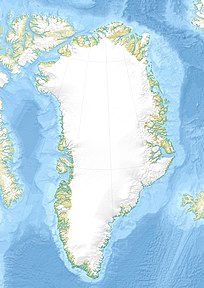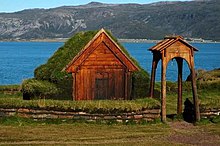Qassiarsuk
| Qassiarsuk (small meeting place) | ||
|---|---|---|
| Brattahlíð (steep slope) K'agssiarssuk |
||
| Qassiarsuk (2011) | ||
| Commune | Kujalleq municipality | |
| District | Narsaq | |
| Geographical location | 61 ° 9 '8 " N , 45 ° 30' 54" W | |
|
|
||
| Residents | 34 (January 1, 2020) |
|
| founding | 1924 | |
| Time zone | UTC-3 | |
Qassiarsuk [ ˌqasːiɑsːuk ] (the old spelling K'agssiarssuk ) is a Greenlandic settlement in the district Narsaq in kujalleq .
location
Qassiarsuk lies deep inside the Tunulliarfik (Eriksfjord) on its west coast. On the opposite side of the fjord is Narsarsuaq , while the route between the two places around the fjord end is peppered with many small shepherd settlements. The district capital Narsaq is 39 km southwest at the point where the Tunulliarfik with the Narsap Ikerasaa has a connection to the north running Ikersuaq (Bredefjord).
history
Qassiarsuk is on the spot where Erik the Red settled in Greenland around 985. Here he founded the settlement Brattahlíð , which is known for its church , the first church built in Greenland, the foundations of which can still be found today. The place was the first settlement of the Grænlendingar who had lived in Greenland for centuries .
The present place was founded in 1924 by the sheep farmer Otto Frederiksen. There were already abandoned houses at the site, with skeletons lying in them, suggesting that the place did not have favorable living conditions, as the fjord was frozen deep inland in winter. When it was re-established in 1924, Qassiarsuk, whose name refers to the thing of the Northmen, was the first shepherd's settlement in modern Greenland after Igaliku, which had previously been used for agriculture . In 1930 there were already 53 people living in Qassiarsuk. In 1936 a school chapel was built in Qassiarsuk. In 1940 the place had 79 residents. In 1949 a warehouse was built and later the KGH opened a shop. In 1950, 129 people lived in Qassiarsuk. Ten years later there were 154, of which around 25 were sheep farmers who owned over 10,000 sheep. Other branches of the economy virtually did not exist. Only foxes were hunted (to protect the sheep). From the 1960s, the population fell sharply. In 1970 only 83 people lived in the village. Today Qassiarsuk is the largest shepherd settlement in Greenland and as such has the status of a village.
economy
Qassiarsuk is economically almost exclusively dependent on sheep farming. About 8500 sheep belong to the shepherds of Qassiarsuks. Every year 150 tons of sheep are slaughtered in the slaughterhouse in Narsaq. The second mainstay of the place is tourism. Tourists are attracted by the ruins of Brattahlíð as well as the recent reconstructions of the church and a nave . Furthermore, Qassiarsuk is part of the Kujataa UNESCO World Heritage Site . Qassiarsuk is just a five-minute boat ride from the international airport in Narsarsuaq .
Infrastructure and supply
The port of Qassiarsuk consists of a six meter long pier built in 1976 and a pontoon jetty. There are gravel roads in the village that lead out of Qassiarsuk and connect it with the other shepherd settlements in the area and lead to Narsarsuaq.
There is no sewage network in Qassiarsuk and garbage is burned in the north of the village. Electricity is generated by a power plant built in 1988 and renovated in 2009. In 2017 the waterworks was modernized, but at times it had to contend with water shortages.
Development
Qassiarsuk has scattered houses in the middle of the ruins of the Grænlendingar and Inuit. The school in Qassiarsuk is responsible for all children of the shepherd families in the area, which is why a school home is attached to it. In 1961, when the school was being built by Otto Frederiksen's son-in-law Lars Motzfeldt , the skull of Erik the Red was found by chance during construction. Because the school and school home are infested with mold, the students are currently being taught in the local meeting house and café. The village office is also located in the service building, which contains sanitary facilities. There is also a fire brigade in Qassiarsuk. There are two overnight accommodations for hiking tourists. The residents are supplied with goods via a Pilersuisoq branch. The church of Qassiarsuk is classified as worthy of preservation, while three buildings constructed by Otto Frederiksen have been listed as historical monuments since 2015.
Population development
The population of Qassiarsuk has more than halved in the past 40 years. This makes the place the second smallest village in the district today.

Web links
- Qassiarsuk at visitgreenland.com
Individual evidence
- ↑ Map with all official place names confirmed by Oqaasileriffik , provided by Asiaq
- ↑ Brattahlíð in Den Store Danske
- ↑ Nogle Smaapluk fra with Arbejde som Faareholder. in the Grønlandsposten from November 1, 1945
- ^ Qassiarsuk in Den Store Danske
- ↑ Jens Christian Madsen: Udsteder og bopladser i Grønland 1901-2000 . Atuagkat, 2009, ISBN 978-87-90133-76-4 , pp. 41 .
- ↑ Narsaq at groenlandkreuzfahrt.de
- ↑ a b c Qassiarsuk at kujalleq2017.odeum.com
- ↑ a b Nomination to UNESCO's World Heritage List - Kujataa - a subarctic farming landscape in Greenland (nomination of the Kujataa region for the UNESCO World Heritage List) (.pdf; p. 65ff)
- ↑ Population of Qassiarsuk 1977–2020 at bank.stat.gl



